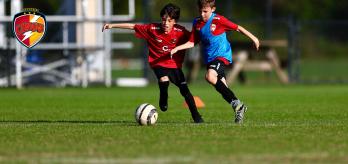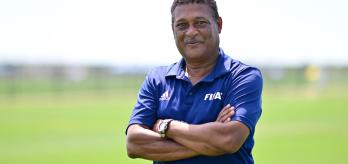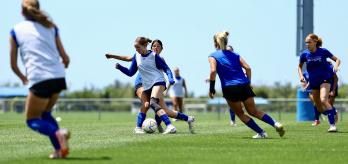The club offers its young talent training sessions focusing on specific topics for a week at a time, varied training exercises and different coaches, each with their own personality. It’s not just about skills and tactics, but also about risk, creativity and fun. Two of the club’s core principles focus on building on the shoulders of those who came before and on growing local talent. The motto: “I want to do it, have fun and give it my all” reflects the club’s values.
Topic-based training plans
The club’s training methods follow a clear, structured plan that is drawn up by the youth department’s coaches. Each training session is based on the topic of the week or month, for example “turning and ball control”, “feinting”, “passing and receiving” and “shooting and scoring”. These topics are used for all the youth teams and are the basis of all training sessions.
Training building blocks
Each session starts with a general section, where the players learn the basic techniques. This is where the focus is on physical skills, such as eye-foot coordination. Quick feet exercises are done with and without a ball. Ball control is trained in other creative ways, such as football tennis, before starting with the topic-specific training stage.
Two sessions, two concepts
Developing training sessions follows a dynamic approach to improve the players’ individual skills as well as teamwork. “Every week, there are two types of training sessions,” explains Maarten Dekocker, coach for the U-8s and U-9s. The first training session of the week is composed of two topic-based learning periods following the general section. Next, players do exercises to work on basic technique, without being marked. This is followed by practice with an opposition player, so that the skill can be practised in a small-sided setting. At the end of each training session, a number of different small-sided games, from 1v1 to 4v4, are held.
The second training session of the week looks more closely at competition formats, and the children have the opportunity to make decisions, for example whether to dribble or pass, or even to decide together whether something was a foul. The aim is that they learn to quickly identify situations and react accordingly. Creativity and risk-taking are central components of training.
Rotating coaches: More eyes see more clearly
RFC Mandel United has introduced a “coaching carousel” where children are trained by several coaches. The aim is for the players to benefit from different coaching styles and input. The coaches move from team to team, helping the players to learn about football in a variety of ways. There are team coaches and individual coaches who establish the priorities, and the continuous exchange between coaches is essential to evaluate the concept.
At the avant-garde
By combining structured training plans with a “coaching carousel”, RFC Mandel United creates an environment for each player’s individual development. The different training styles and the close cooperation between the coaches ensure that the children learn a wide range of skills and keep on developing, both technically and personally. “We’re very keen to build on this system and hope that our initial positive impressions are confirmed,” said Dekocker.
Part 1: Find the target
-
Place three cones and a mini-goal, as depicted above.
-
A player stands next to one of the cones closer to the goal. The other players line up at the starting cone.
-
The player with the ball passes to the player at the cone closer to the goal, who receives the ball and tries to score in the mini-goal.
-
Once the player receives the ball, they dribble towards the other cone, turn in front of the cone and shoot.
-
Encourage players to shoot as quickly as possible
-
Make sure the players also complete the exercise with the weak foot
Part 2: Control and finish
-
Mark out a 15m x 15m area with mini-goals in each corner, as depicted above.
-
Mark each mini-goal with a colour.
-
The players are divided into two equal groups and are positioned at the two starting points.
-
The player with the ball passes to the player opposite them on the other side of the marked-out area.
-
Before the ball reaches the player, the coach shouts out a colour.
-
The player has to react quickly and shoot at the mini-goal marked with that colour.
-
Encourage players to shoot quickly with the second touch
-
Players should take the ball towards the target goal with their first touch
Part 3: Dribble and win a duel
-
Mark out a circuit with mini-goals, as depicted above.
-
Split the group into two and position each group at one of the two starting points.
-
The player with the ball dribbles around the circuit and then tries to get past the defender and score.
-
Encourage players to experiment with various ways to beat the defender
Part 4: 1v1
-
The playing area should be marked out as described above.
-
Create two teams and position the players as depicted above.
-
The defender plays the ball to the attacker.
-
In a duel, the attacker now attempts to get past the defender and score.
-
If the defender wins the ball, they can try to score in either mini-goal.
-
Players should switch to defending after losing the ball
-
Point out the importance of a good first touch
-
Attackers should aggressively take on the defenders
Interview with Kris Van Der Haegen
What is the story behind Royal FC Mandel United?
Royal FC Mandel United are the offshoot of several smaller clubs that had a rich pedigree in amateur football, but which had been left in dire straits due to management upheaval and structural issues. They decided to join forces to build a stronger club: one that would be equal to the challenges at hand. One of the most pressing missions after that merger was to forge a shared identity, since each of the previous clubs had its own history and culture.
What is the club’s goal?
The ultimate goal is to reach the professional ranks by working their way up to the second division, the Challenger Pro League. A crucial first step was to gain a foothold at the top of the amateur game. Mandel United are investing in youth development with a view to delivering the goods on the pitch and continuing to progress up the pyramid. However, it won’t be easy given the fierce competition. As a result, their focus is on putting a strong structure in place as a platform for long-term success.





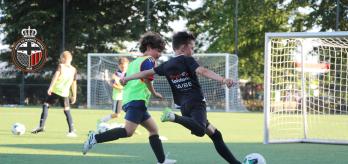
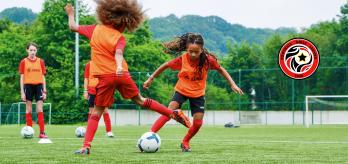


.variant64x64.jpg)

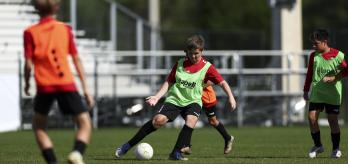
.variant348x164.jpg)
